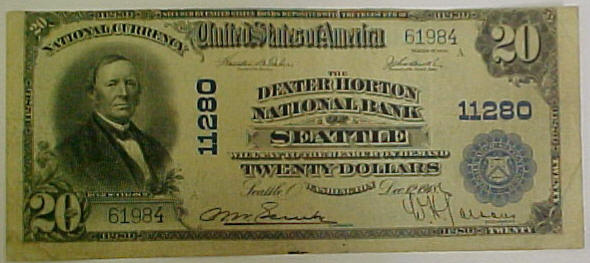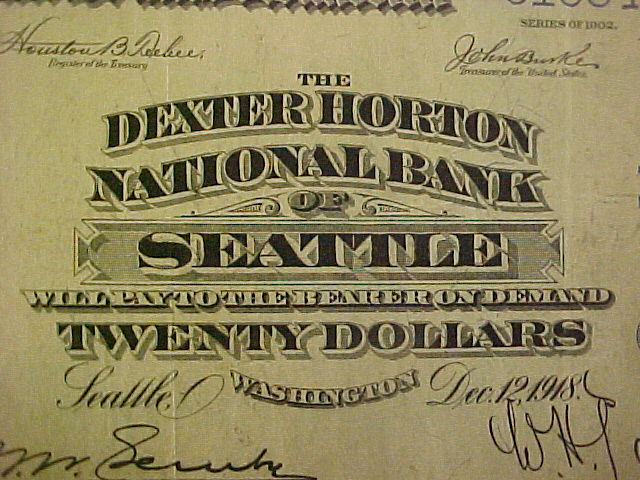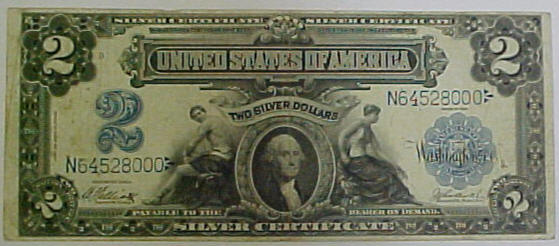U.S. Dollar
History:
From a Gold Standard Currency
to a Fiat Money System
x


This
1928 ten dollar gold certificate is an example of when U.S. Dollars
were still backed by the Gold Standard.
We live in a time of near
invisible money. When we pay for goods or
services we have a multitude of options other than dumping cash on the
counter. Our wallets are stuffed with credit cards that help us buy all
the things we need without ever seeing a real dollar exchange hands.
Our bank accounts are digital blips in an electronic world mostly
revealed to us through account statements rather than in actual cash in
hand. The barter and trade culture of the distant past,
necessary for the transfer of goods between parties but incredibly
inefficient, has evolved in the United States into a highly efficient
federally regulated fiat money system that is now almost unrecognizable
next to its simple origins.
In 75,000 B.C. snail shells were currency in some parts of South
Africa. In Aborginal Australia ochre (a color pigment made from
the earth) was used. Many early
societies adopted jewelry, usually shell, ivory, or other rare
commodities, as a means for barter and wealth savings. Much of the time
it was often key goods that found themselves as the going currency,
such as in the early British Colony of South Wales in Australia where
rum became the trade good of choice.


Trade beads such as those
pictured to the left are a far cry from today's electronic economy.
Whether beads, conch shells,
animal furs, rare metals, or something else, societies have always
needed some mode of transferring goods to those who need them in a
manner that is efficient for both sides. It is a natural market
phenomenon that traders are looking for a fair trade. But what if the
currency is easily counterfeitable, or the goods to be traded come from
opposite seasons of production, or politics are allowed to take
precedence over monetary stability? The evolution of good money
systems is an evolution of efficiency. The economic history of
man is littered with examples of failed currency systems.


Left: Zimbabwe dollars have experienced an
inflation rate well over 7000% from 1998 to 2007.
Right: In 1923 in the Weimar Republic (German state from 1919 to
1933), it took 1 trillion marks to buy one U.S. dollar. The note
pictured is 50 million marks.
Even in these
modern times, challenges remain. Anyone with the
desire can open a newspaper to the financial section and read about the
ongoing demands of maintaining an efficient monetary system.
Articles on the US deficit, on the decline of dollar against a huge
basket of foreign currencies, issues of inflation or deflation, are
daily reads. But how did The U.S. Dollar get here? What were the
specific motivations and designs that led from trading beaver pelts for
beads at the Hudson Bay Company to a world of near invisible dollars
backed by nothing but a government promise of value?
The history of the U.S. Dollar formally begins in the mid-1780's when
it was decided that the term Dollar would be the official measurement
of the monetary system in the United States. This seemed a reflection
of the fact that Americans were already comfortable with the word
Dollar since the Spanish currency in circulation at the time was of the
same name. In 1791, in what seems a natural progression, the
first U.S. bank opened its doors. From there The Dollar's path
becomes very intriguing. The first official coins under the
Dollar system were minted in the late 1780's and, not much later, state
banks began minting their own individual currencies.


Left:
Massachusetts-Bay 7 dollar continental bill from 1780. Right:
Hand Signed Bank of South Carolina 5 dollar bill from 1807.
More than 30,000 state
bank notes with a variety of
colors, sizes, and designs, were issued across the nation. Due to a
lack of federal regulation, the bills were easily counterfeited and led
to major problems, both for the state banks and for consumers. To
complicate matters, along came the American Civil War which almost
bankrupt the country and forced congress to take action on the currency
situation. By taxing local state currencies out of existence with the
National Banking Act, the federal government was able to issue an
official nation-wide currency for the first time in the form of
non-interest bearing treasury notes called Demand Notes. This process
quickly led to the creation of Greenbacks in 1862 which were backed by
Spanish dollars. Counterfeiting had taken its toll, and the new
bills were designed with "fine line engraving necessary for
difficult-to-counterfeit intaglio printing, intricate geometric lathe
work patterns, and distinctive linen paper with embedded red and blue
fibers." The United States Dollar, as we know it, was established.



Dexter
Horton National Bank U.S. Dollar "National Currency" from 1902 backed
by "bonds deposited with the treasurer of the U.S."
x
There was one major difference
from those dollars of yesterday and
those we use today. From 1792 through 1874, the US dollar was
freely backed by both gold and silver. Under this system, dollars could
be exchanged for their set value in gold or silver from the U.S.
Treasury. Gold was traditionally the most popular unit of support
for the dollar but powerful factions in the silver producing industry
continually managed to influence policy. That is, until huge
silver deposits were discovered in Western United States in the late
1800s. This effectively devalued the silver content in U.S. coinage,
and sent the country into a furious debate over the bimetallic
standard. This led to a division of the democratic party in 1896 as
each side of the party argued with their own interests at heart.
The United States Greenback
Party, supported primarily by farmers, felt
that keeping the system of Bimetallism would be in their best interest
because it would lead to inflation, and consequently make it easier for
them to repay their land debts. On the other hand, financial
institutions and commercial businesses argued that a stable dollar was
more important than the farmers' predicaments, and that the dollar
should be backed only by gold to effectively achieve this stability. It
is little wonder that the farmers lost the battle and from 1873 to 1900
legislative modifications led to the introduction of the Gold Standard.


U.S.
Dollar Bison note from 1901. This United States Note was the only one
to mention the legal provision that authorized its issuance.
x
The Gold Standard Act passed on
March 14th 1900, and with that, all
dollars were backed entirely by gold. But, as the constant
evolution of the Dollar system has shown, complications and confusion
always seem to arise as the system becomes inefficient. In this
case, the dollars' stumbling began when the post-WW2 Bretton Woods
system valued all other foreign currencies in terms of U.S. dollars,
and consequently indirectly connected their currencies to the gold
standard. At the time, gold had a market price of $35.00 an
ounce; trying to maintain that market price under the pressures of
foreign currencies put a major strain on the system, and once again
resulted in looking at new ways of doing things.
After a failed attempt at creating a two-tier system in which central
bank gold transactions were insulated from the free market price, the
government took a radical step in 1971. They shrugged off the gold
standard and entered a new era by embracing a Fiat Money System as the
best course of action. This new way of doing things was simple:
Remove all physical assets backing the dollar. No conch shells. No
Spanish currency. No silver. No gold. The dollar would now be
backed by just a promise, or as Wikipedia.com states: "backed by future
claims to wealth of American Taxpayers and other income sources of the
Treasury." Thus the dollar went from being a claim on some
physical asset to simply a medium of exchange. Some have argued
that this means the only inherent value left in the dollar is the paper
it is printed on.
Federal Reserve Notes, for the
greater part of their history, always
had the words "Will Pay to the Bearer on Demand;" but by 1963, under a
burgeoning fiat money system, this was removed and by 1968 the
government would no
longer honor gold or silver certificate redemption. This does not mean
that old currency is worthless however. The government still respects
old bills at face value, although paying for your groceries with a
dollar from the 1800s is a pretty bad idea. As historical collectables
go, not many items divulge so much information about the character of
the United States at various times in history as the particular dollar
of that day. The pictures on old bills are such simple and
authentic representations of each period's values and politics, it is
not surprising that many vintage dollars sell for much more on the
antique market these days than they would have ever been worth in gold.
Under a fiat money system, the amount of
silver in coins was also drastically reduced. Where once most coins
contained 90% silver, after the Coinage Act of 1965 they rarely
contained any at all. By 1975 it seems all valuable commodities had
been removed from the monetary process (either in backing or content),
and the United States completely embraced a fiat system. Some
argue the foundation of the dollar is all a confidence game now.


Silver Certificate from 1899
when U.S. Dollars were still backed by BOTH hard assets silver and gold.
x
As a strange as it would be for
a fur trader from the 1800s to
contemplate derivatives, stock futures, and puts and calls, so is it
tough for us to imagine what the future of our currency system might
entail. Technology is always advancing. Efficiencies are always
increasing. Our understanding of market economics is continuously being
pushed forward by experience.
These days, with high tech methods of safeguarding the authenticity of
our currency with such things as security thread and microprinting, the
new fear has become more about the authenticity of the person spending
those funds than the actual dollar bills themselves. In a world
of invisible money, identity theft is rapidly becoming a huge
problem. To battle this growing inefficiency in today’s currency
system, new ways of doing things are inevitable.
Perhaps the credit cards we use
today will be replaced by personalized
microchips under our skin tomorrow. Perhaps when we shop for groceries,
cashiers will be completely unnecessary. Perhaps when we leave the
store, our unique microchip (embedded somewhere on our body) and all
the unique microchips in each of our groceries will be instantly
scanned, charged to our account, and added to our monthly bill.
As distasteful as such a thing sounds now, imagine the fur trader
contemplating a currency with no physical assets backing it, or coins
with no actual value outside of being a medium of exchange. They
would probably think it a bit wacky too.
- Tim Regan
















